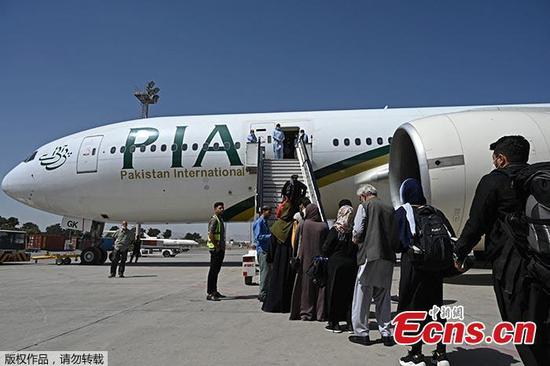The use of drones by the U.S. military against targets in other countries has come under scrutiny again following a deadly strike that it carried out recently in Kabul, Afghanistan, which was alleged to have wrongly killed multiple civilians there, including young children.
U.S. Secretary of State Antony Blinken, appearing before the Senate Foreign Relations Committee on Tuesday, acknowledged that he is not sure whether the U.S. drone strike, launched on Aug. 29, hit a terrorist operative working for ISIS-K, an Afghanistan-based offshoot of the Islamic State, or a long-time employee of a U.S. aid group.
"I don't know because we're reviewing it," Blinken responded to a question asked by U.S. Senator Rand Paul, who replied, "you'd think you'd kind of know before you off somebody with a Predator drone whether he's an aid worker or an ISIS-K."
Over the past several days, The New York Times, The Washington Post, and CNN separately published their investigations, suggesting that U.S. armed forces might have mistaken Zamarai Ahmadi, a 43-year-old electrical engineer working for California-based charity organization Nutrition and Education International, for a suicide car bomber.
The U.S. Central Command previously said the Aug. 29 drone strike had taken out a vehicle in Kabul and eliminated an "imminent" threat, posed by ISIS-K, to the Hamad Karzai International Airport, where evacuations of U.S. service members and personnel were underway, as America was ending 20 years of military presence in Afghanistan.
The Central Command also said "significant secondary explosions from the vehicle indicated the presence of a substantial amount of explosive material." Mark Milley, chairman of the U.S. Joint Chiefs of Staff, has called it a "righteous strike" with procedures correctly followed.
But media investigations have undercut the official account. After conducting interviews with Ahmadi's relatives and explosive experts, along with the examination of the scene of the strike by their reporters, the outlets said there was no evidence of a secondary explosion and that what Ahmadi was loading into his car that day were not explosives but water canisters.
A Hellfire missile, a precision air-to-ground, subsonic weapon with anti-tank capacity, landed on the courtyard of Ahmadi's home in a northwestern Kabul neighborhood in the afternoon of Aug. 29, destroying his white sedan while killing him, two other male adults, and seven children aged between two to 16 years old, according to investigations. The Pentagon has so far acknowledged only three civilian casualties.
A Pentagon spokesperson said on Monday that the Central Command is still assessing the aftermath of the drone strike in retaliation for earlier ISIS-K attacks that killed more than 170 civilians and 13 U.S. service members at the Kabul airport amid the chaotic and bungled military withdrawal. The spokesperson also promised the Pentagon will be "as transparent about the outcomes as we can."
Ashok Swain, professor of peace and conflict research at the Department of Peace and Conflict Research, Uppsala University in Sweden, tweeted on Tuesday that the deadly strike in Kabul "has caught the world's attention" but "U.S. drones killing innocent civilians is not new."
In August, the U.S. website Connecting Vets published an investigation into what it described as "America's failed Afghan drone campaign," in which an operator admitted he had mistakenly killed two Afghan civilians and a child in 2019.
The U.S. drone pilot revealed that they were trying to hit an Afghan man in Helmand Province and fired a missile when his motorbike was traveling on an empty stretch of a road. As he hit an intersection, another motorcycle carrying two adult riders and a toddler passed by coming in the other direction. There was no way to call off the strike.
The operation, however, failed to annihilate the target and the man went through the cloud of smoke and drove off. "My productivity today was derailed," the drone operator wrote in his journal obtained by Connecting Vets, adding that they killed two innocent men and a "charger," using the military jargon term for child.
He and other drone operators also described their dismay at the work with Task Force South West, which was run by U.S. marines in 2019, arguing that they felt their drone strikes served little purpose when the troops had essentially given up on Helmand.
"The drone strikes were punitive. Killing for the sake of killing," he said. "It's nihilistic, there is no point," a second drone operator supporting Task Force South West said. "It was clear that we were not making a difference."
The U.S. military announced on Aug. 30 that it had completed the pullout of its troops from Afghanistan, nearly two decades after it had declared a "War on Terror" and invaded the country following major suicide attacks orchestrated by Islamic extremist group al-Qaida on America's soil on Sept. 11, 2001, which killed almost 3,000 people in a single day.
Over the years, the United States has expanded its warfare to several other countries, relying heavily on drone strikes for targeted killings, denounced by human rights watchers as extrajudicial actions that also indiscriminately take civilian lives.
An analysis published by the civilian harm monitoring group Airwars this month showed U.S. drone and airstrikes have killed at least 22,000 civilians -- and potentially as many as more than 48,000 -- since the Sept. 11 attacks in 2001.
The Barack Obama administration expanded the U.S. military's drone program in its first term but then tightened restrictions on the strikes in the second term. His successor, Donald Trump, loosened the rules for drone strikes when he was in power. Joe Biden, after taking office early this year, asked his national security team to review America's counterterrorism policy, including the use of drones.
More than 100 organizations in the United States and around the world sent a letter to the White House in June, urging Biden to end U.S. drone strikes outside of traditional combat zones. "We write to demand an end to the unlawful program of lethal strikes outside any recognized battlefield, including through the use of drones," the organizations wrote.
"Disavowing and ending the lethal strikes program is both a human rights and racial justice imperative in meeting these commitments," they continued. "Twenty years into a war-based approach that has undermined and violated fundamental rights, we urge you to abandon it and embrace an approach that advances our collective human security."

















































